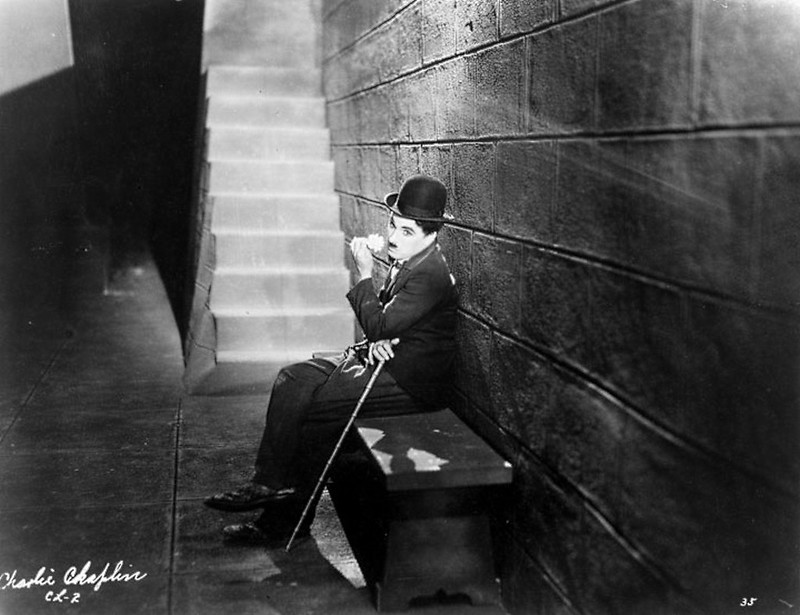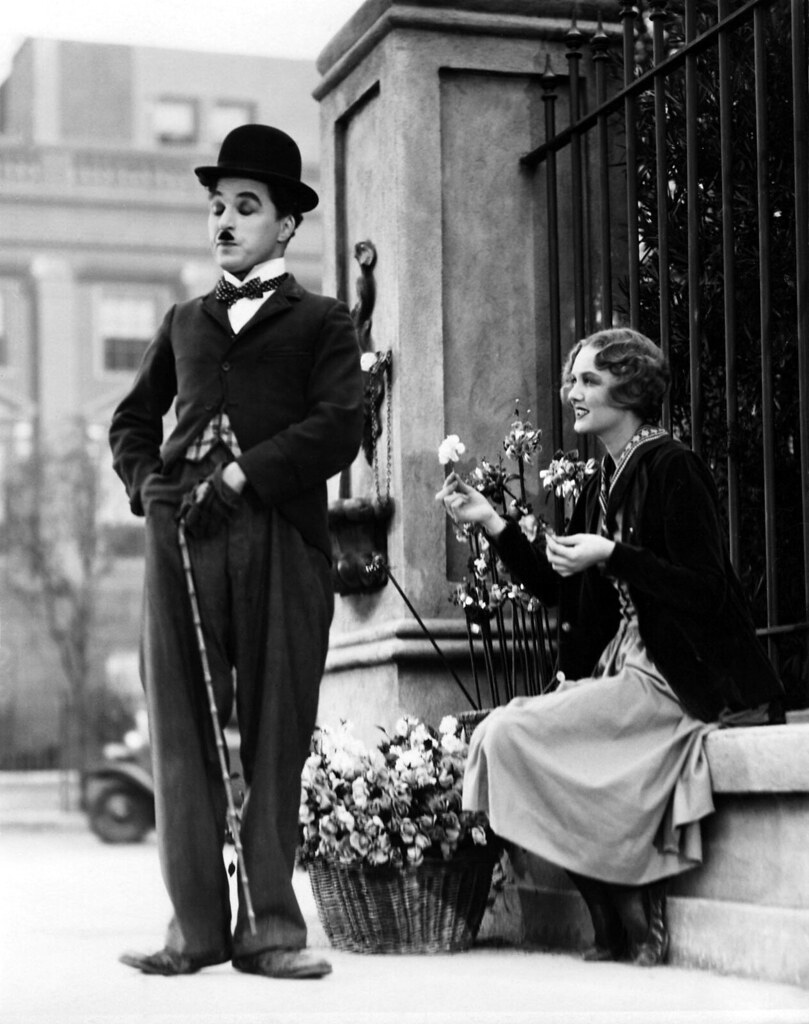City Lights had its gala premiere ninety years ago today– January 30, 1931–and after all this time, its brilliance has not dimmed. Its images have remained with us ever since. City Lights is something more than a comedy. It’s a special place that reminds us of our humanity. Life in any city can be heartless, but here within this urban setting is a tale of love and hope. As the film unfolds, we also witness the poetry of cinema. It’s the film that summarizes all the elements of performance that define Charlie Chaplin and show his wide range: the graceful pantomime, the acrobatics, and the pathos punctuated by that gentle touch of slapstick.
City Lights is a simple story of two lost souls who find one another in an unstable world: the gentleman tramp who aids a blind flower girl. Its simplicity in structure masks the fact that this was Chaplin’s most difficult film, taking over two years to complete. The end result is a film that fits together as easily as a jigsaw puzzle; the pieces could not have fit any other way. Chaplin’s original idea had been to tell a story of a blind clown. He kept this theme of blindness throughout the various story incarnations, but he always had a sense of the story’s endpoint. (Having a blind girl as the heroine recalls The Strong Man from 1926, directed by Frank Capra. This is, incidentally, considered Harry Langdon’s best film.)
Chaplin cast 20-year-old Chicago socialite (and recent divorcee) Virginia Cherrill in the role of the flower girl. According to one version, he had met her ringside at a prizefight. Cherrill had no previous acting experience, but it is possible that this deficiency helped her be convincing in the role and to appear blind without seeming to over-act. Chaplin’s advice to her was simply to look at him but “to look inwardly and not to see me.” Their working relationship, however, was strained from the beginning. Perhaps it was her boredom derived from production delays and inactivity, but she never fueled his enthusiasm. Things deteriorated further when Virginia asked to leave the set for a hair appointment. Chaplin immediately fired her.
Virginia Cherrill was not the only one to have been fired from the production. Australian artist Henry Clive had originally been cast as the suicidal millionaire whom Charlie “rescues,” but when he refused to jump into the pool on the third day of filming, he was let go and replaced by Harry Myers, who is magnificent in the role. Charlie, meanwhile, replaced Virginia with his Gold Rush co-star, Georgia Hale. (There is a fascinating screen test of Hale which can be found on the dvd.) But Chaplin faced the reality that too much of City Lights had already been completed with Virginia. He was therefore forced to bring her back (after he acquiesced to her new contract demands).
Chaplin had said that he worked himself up into what he called a neurotic state of wanting perfection. Most likely the stress and anxiety of making a silent movie in the sound era added to this state. Charlie’s first meeting with the flower girl was shot over 300 times, marking what would become a Guinness World Record for retakes. In Chaplin: Genius of the Cinema, silent film historian Jeffrey Vance writes, “He would not hesitate to retake a scene if he felt she was holding a flower improperly, if the timing of her movement was off, if she was not completely concentrating on the scene, or even if she spoke the line of dialogue, ‘flower, sir?’—which no one would hear in the finished film—incorrectly.”
A silent movie in 1931 was an anachronism, but Chaplin felt there was no way he should make his most famous character speak. Before sound shattered the silence around him, the Little Tramp had become a universal figure recognized in every culture. Speech would’ve robbed him of his connection to the global audience. The Little Tramp, as we knew him, never did speak dialogue. (Sound never did render him obsolete. When forced to finally utter something in 1936’s Modern Times, Chaplin found a clever way around it!)
When the sound revolution came, many of the early talkies were quite stagey and visually-dull affairs. Films had lost the cinematic technique. But City Lights—a deliberate, conscious throwback to the world of silent cinema—could speak to us with the power of the image. The fabled city of the Little Tramp and the flower girl was a world where emotion could be conveyed through the power of pantomime. “Everything I do is a dance,” Chaplin had said of his process. “I think in terms of dance. I think more so in City Lights. The blind girl—beautiful dance there. I call it a dance. Just purely pantomime.” Charlie Chaplin was cinema’s greatest mime and a wizard of storytelling who knew how to reach every viewer. Chaplin had, in his own unique way, turned slapstick itself into a dance. It is a style of film-making removed from the broad knockabout most people associate with silent comedies.
City Lights contains a musical score composed by Chaplin himself, as well as an interesting use of synchronized sound effects– most notably the use of kazoos to speak for the politicians in the opening scene. It’s been suggested that this was Chaplin’s dig at movie dialogue. He shows us the irrelevance of words. Fittingly, they are coming out of the mouths of politicians. Modern audiences, naturally, are trained to accept sound and the spoken word. They need it as badly as they do color, but these elements are no guarantee of a higher quality film. Sound and color enhance reality, but the silent clowns existed in a world of exaggeration.
Few films of its time had the freedom of movement and pace of City Lights. Faster and more exciting than anything around it, the film moves with an ease and grace in which every scene is loaded with ingenious gags. Each scene has the right balance between naturalism and exaggeration. Every scene, indeed, is inspired– none more so than its final moments.
The last sequence, in which the girl is able to see the Tramp for the first time, is one of the great emotional scenes of cinema. I stress emotional rather than cinematic. It’s a very simple camera set-up and it’s easy to spot the continuity errors—for instance, a viewer will notice how the flower Chaplin is holding seems to move as we cut back and forth between him and the girl. But this is trivial. The sequence contains great emotional power—the power of performance—and that, for Chaplin, had always been more important than any technical incongruities.
In later years Chaplin said, “I had one close-up once, in City Lights, just the last scene. One could have gone overboard… I was looking more at her and interested in her, and I detached myself in a way that gives a beautiful sensation. I’m not acting… almost apologetic, standing outside myself and looking, studying her reactions and being slightly embarrassed about it. And it came off. It’s a beautiful scene, beautiful, and because it isn’t over-acted.”
We don’t even need the inter-titles to understand it because it’s all there visually. Critic James Agee, the author of the essay “Comedy’s Greatest Era,” said of the film’s ending, “It is enough to shrivel the heart to see, and it is the greatest piece of acting and the highest moment in movies.”
When I presented the film at the Park Ridge Public Library as part of the original “Legends of Laughter” series, a viewer commented to me afterward that she thought the music in the final scene was too sad, too sombre for a “happy” ending. Though it’s the ending we had hoped for, can the Tramp ever really find happiness and love? Or will he forever be on that road alone? Chaplin was too astute a filmmaker to use music cues that would hit audiences over the head. There is a reason this moment is so iconic the way it is, and the music– in keeping with the tone of the earlier themes– makes it so.
Orson Welles had called City Lights his favorite film. It could be argued that this is Chaplin’s finest film. It is a showcase of Charlie Chaplin as the complete auteur. Now, on the occasion of its 90th anniversary, we invite viewers to discover– or revisit– this landmark film whose roots run deep in the silent film tradition.
~MCH



